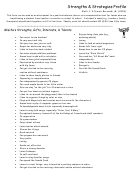Strengths & Strategies Profile Page 2
ADVERTISEMENT
What Works for Mischa?: Effective Strategies
genuine and gentle encouragement
•
telling her when she is doing something right
•
a calm and gentle approach
•
whispering instead of using a firm voice
•
giving her lots of choices
•
pre-teaching difficult lesson content
•
asking her opinion
•
giving her responsibilities
•
letting her use a pencil grip
•
humor
•
letting her work with friends
•
letting her call her mother if she seems stressed out
•
letting her use her red pens
•
letting her sit on the floor when she asks to
•
showing her instead of telling her
•
let her take the spot at the end of the line
•
explaining EVERYTHING in detail
•
she sometimes responds better to written “speech”
•
using visual information (charts)
•
giving her time to work on her own (don’t over support)
•
telling her something about yourself (she likes to hear about her teachers’ children and dogs)
•
asking her to “read” to other students – even if it is just showing them a picture book
•
giving her previews- if you are taking a field trip to a museum, tell her about it
•
encouraging her to “do her positive self-talk” if she seems frustrated by a task
•
letting her review her “recess choice” book before going on the playground
•
having her start the day by looking at her favorite farm magazine
•
letting her “read” more than one book at a time, she spreads them out and reviews 2 at once
•
allowing her to occasionally do her math problems on the chalk board (this is very motivating)
•
letting her send e-mail to friends (helps her work on her writing skills)
•
ask her to help with organizing things in the classroom (e.g., straighten library books)
•
challenge her with hard questions related to her areas of interest (farm animals, Sponge Bob)
•
give her opportunities to share her “All About Me” book with friends
•
she may need to circle the table before he takes a seat- allow her to do this
•
sometimes likes to know exactly where her work space is (you can tape it off to show her)
•
helping her to change topics by bringing up special interests
•
may need to take little “safe spot” or relaxation breaks
•
use Sponge Bob to interest her in activities- for instance, let her write stories about him
•
using photographs to interact with her
•
letting her help to teach a part of a lesson (she likes to help the teacher)
•
giving her something squishy to play with during whole-class work (koosh ball)
•
giving her time to respond (several seconds) to verbal questions or commands
•
giving her breaks to move around the room
•
letting her choose where she wants to sit (floor, desk, back couch)
•
letting her choose one item on a test or worksheet to omit (calms her down)
•
giving her headphones for music during independent work
•
singing Beatles songs during times of stress
•
loves the smell of lavender
•
can work for long periods of time when she is allowed to hum and rock in her chair a bit
•
if she seems confused, write the steps or directions on a chalkboard (use pictures too)
•
hum to her when she is stressed and let her hum also
•
ADVERTISEMENT
0 votes
Related Articles
Related forms
Related Categories
Parent category: Business
 1
1 2
2 3
3 4
4








